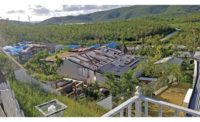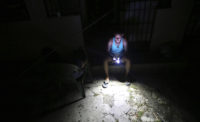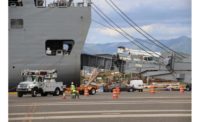As of Sept. 27, about 70% of Puerto Rico's 1.5-million customers have power after Hurricane Fiona knocked out all electrical service on Sept. 18—further damaging a grid still largely unrepaired from the devastation wrought by Hurricane Maria five years earlier, despite billions of dollars in appropriations. The Fiona havoc, mainly affecting the grid and water infrastructure, comes amid protests and calls for action and accountability from government officials over the lack of progress in rebuilding the grid after Maria.
Fiona made landfall as a Category 1 storm, bringing up to 35 in. of rain in places and wind speeds nearing 115 mph, according to the National Hurricane Center. Luis Deya, public affairs officer with the U.S. Army Corps of Engineers (USACE), says power distribution and water supply infrastructure were hit the hardest, but roads and bridges also suffered major impacts.
President Joe Biden approved the request by Puerto Rico Governor Pedro Pierluisi (I) for an expedited major disaster declaration Sept. 21, according to the Federal Emergency Management Agency (FEMA). USACE has enacted emergency permitting procedures for the island through next March 21.
Biden’s declaration will pave the way for federal assistance for Puerto Rico. But others take issue with how little of post-Maria allocations have been spent to date.
The Puerto Rico Electric Power Authority, which owns and operates generation, transmission and distribution facilities serving all of Puerto Rico, provides electricity to about 1.5 million customers on the island of more than 3 million people. In June 2020, PREPA chose LUMA Energy, a private enterprise by parent companies ATCO and Quanta Services, to operate, maintain and modernize the island’s grid for 15 years, through a public-private partnership.
Lack of Progress
New York State Attorney General Letitia James called for an investigation into LUMA and Puerto Rico’s energy infrastructure, and U.S. Senate Majority Leader Chuck Schumer remarked on Puerto Rico’s lack of progress on the Senate floor. In a press conference Sept. 20, Schumer said $21 billion was allocated to Puerto Rico following the 2017 storm, including $12 billion earmarked to rebuild the grid, yet only 2% of the money has been spent to date.
Juan Rodríguez, vice president of capital programs for LUMA, says that when LUMA began its contract just over a year ago, it inherited a grid not built to standards and not properly maintained. He says estimates are ongoing, but damages will tally in the hundreds of millions or billions of dollars.
He says LUMA is focusing now on restoring power by conducting critical work, such as replacing broken poles and conductors and bringing downed wires back into service.
About 70% of its customers are back in service as of Sept. 27, Rodríguez says, as crews and contractors have completed surveying transmission lines while continuing to battle the island’s steep geography and narrow roads with limited access to continue restoring power to those who are still without power.
LUMA says that about 50% of the island's electrical grid infrastructure incurred damage from the storm, and that depending on damage assessments and generation availability, it expects power to be restored to between 77% to 91% of its customers by Sept. 30.
In 2021, Burns & McDonnell was announced as project manager by PREPA for an up to $27.6-billion effort to rebuild and modernize its electric grid, funded by FEMA and the U.S. Dept. of Housing and Urban Development.
In April, FEMA announced that after approving nearly $9.5 billion in funds in September 2020—the largest funding allocation in the history of the agency’s public assistance program under its Accelerated Awards Strategy—the federal agency had yet to receive any transmission and distribution projects for evaluation and approval, and had received only five substation projects and five generation projects for review.
In just over a year, Rodríguez says LUMA has developed more than 200 work order packages for FEMA, 14 of which are currently in the execution phase.
“This is a huge challenge,” he says. “The state of the grid as we took over as the operator—it was just really bad.”
Challenges with the existing infrastructure include below-standard installations and materials, Rodríguez says, as well as a lack of maintenance and maintenance records.
The big goal now is to harden the grid, he says, working with FEMA to develop a grid capable of withstanding 160-mph winds with added redundancy and more to bring it in line with 21st-century standards. That includes microgrids, automation and updated technology.
On Sept. 20, Maria’s fifth anniversary, the National Institute of Standards and Technology (NIST) released a progress report on its ongoing study to understand Puerto Rico's wind environment, performance of critical buildings, the performance of emergency communications systems and the storm’s impacts on businesses, hospitals and schools.
Joe Main, the lead for NIST’s Maria study, says a hurricane hitting the island amid the vulnerability of that unfinished work is what they were hoping wouldn’t happen and that after Maria, recovery was fairly slow with reconstruction only starting recently.
“If we look across the U.S. at recovery from any major hurricane or other natural hazard event, you’ll see that the timeline is a really long one,” says Maria Dillard, associate lead for the NIST study. “There haven’t been a lot of great quantitative studies to document the full process for recovery for communities internationally or in the U.S.”
Main and Dillard say one positive dynamic is the more widespread use of backup generation systems that kept some facilities in operation through the storm.
Knowing the variety of building types on the island, including some with repairs still incomplete, created a lot of concern as the storm was approaching, Dillard says, something she hopes the NIST study can help with by recommending changes to building codes, standards and practices.
NIST issues its final reports up to seven years following an event, Main says. After that, it follows up with other agencies and organizations to reach a consensus, with building officials and other stakeholders, on any new standards recommended and their implementation, as it did after the tornado that struck Joplin, Mo., in 2011.
After Maria, according to Puerto Rico’s Transparency Portal, the territory was allocated $80 billion in overall disaster recovery funds, of which $67.8 billion was obligated and $24.5 billion disbursed.
Preparing for Storms is a Tall Task
Michel Bruneau, a professor of engineering at the University at Buffalo, says there is a lot of finger pointing regarding Maria and now Fiona, but preparing for storms like those is a tall task. “Many countries can do introspection here and see that they are not as prepared as they think they are,” he says. “And many countries have embarked on plans to enhance resilience.”
Implementation can take as much as 30 years and become a race against time, says Bruneau, author of the Blessings of Disaster: The Lessons That Catastrophes Teach Us and Why Our Future Depends on It (Prometheus, 474 pages)—a study of recent disasters.
Deya says the USACE is still evaluating its ongoing projects to determine if they took any damage. It received $2.4 billion in construction funds and $13.9 million in investigation funds through the Bipartisan Budget Act of 2018 (BBA18) to complete existing flood control projects and create new projects to mitigate damages from hurricanes Maria and Irma, he says.
“We already completed seven short-term projects and four studies,” Deya says. “We are still working on five long-term projects, which represent most of the efforts."
The goal is to complete all remaining efforts under BBA18 by 2032, he says. After inspecting each of the completed projects around the island, USACE found no damages.







Post a comment to this article
Report Abusive Comment